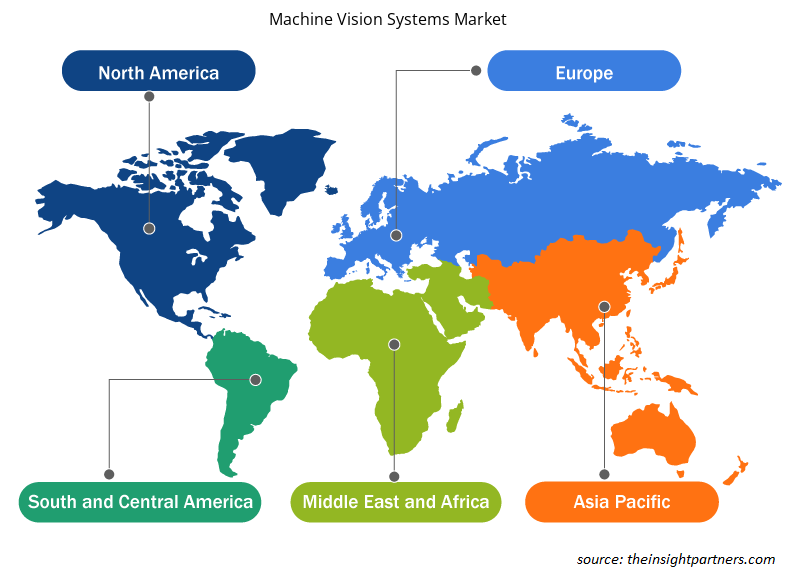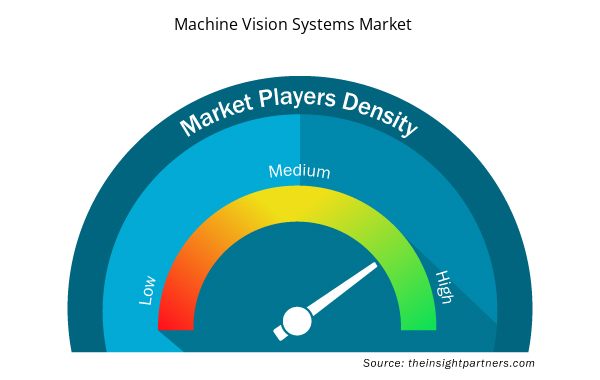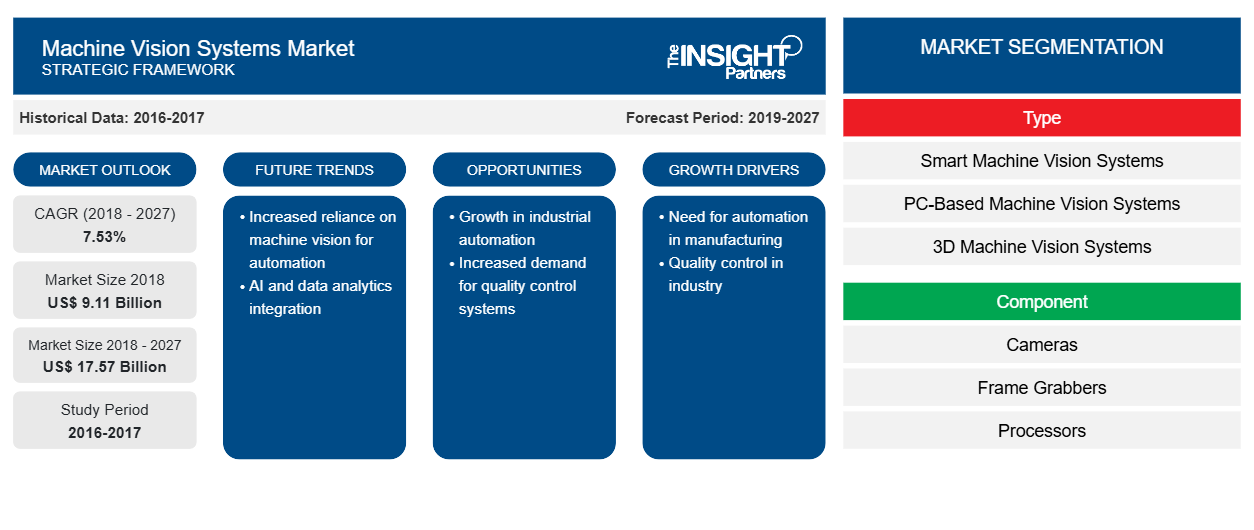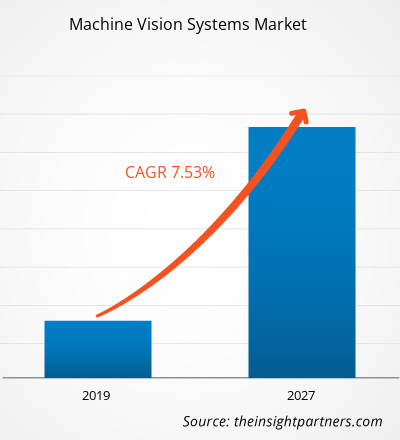بلغت قيمة سوق أنظمة الرؤية الآلية 9.11 مليار دولار أمريكي في عام 2018 ومن المتوقع أن تصل إلى 17.57 مليار دولار أمريكي بحلول عام 2027؛ ومن المتوقع أن ينمو بمعدل نمو سنوي مركب قدره 7.53٪ من عام 2019 إلى عام 2027.
أنظمة الرؤية الآلية هي الجيل القادم من الأنظمة الذكية المستخدمة بشكل أساسي في التطبيقات الصناعية للكشف والتحديد والقياس والتفتيش وما إلى ذلك. تلعب هذه الأنظمة أدوارًا رئيسية في مجال الروبوتات؛ تُستخدم لتوجيه الروبوتات المستقلة والمعروفة أيضًا باسم "الروبوتات ذاتية التوجيه". تهتم العديد من الصناعات مثل صناعة السيارات والأغذية والمشروبات والأدوية كثيرًا بتقليل العمليات التي تتطلب عمالة كثيفة وزيادة الدقة والسرعة؛ هناك طلب كبير على أنظمة الرؤية الآلية للتغلب على هذه المخاوف. يمكن لأنظمة الرؤية الآلية أداء مهام متكررة معقدة بدقة وثبات أعلى. تتضمن أنظمة الرؤية الآلية مكونات مثل أجهزة استشعار الصور والمعالجات وPLC وأجهزة التقاط الإطارات والمزيد، والتي يتم تشغيلها بواسطة حزمة برامج لتنفيذ تطبيقات محددة من قبل المستخدم. تُستخدم أنظمة الرؤية الآلية أيضًا في التطبيقات غير التفتيشية مثل توجيه الروبوتات واختيار الأجزاء ووضعها وتوزيع السوائل وغير ذلك الكثير. من المتوقع أن يشهد سوق الرؤية الآلية ومكوناتها نموًا كبيرًا في السنوات القادمة بسبب الطلب المتزايد في الصناعات مثل الأتمتة والروبوتات وغير التصنيع والتي تشمل نظام النقل الذكي والخدمات اللوجستية والطبية، مما يُظهر نموًا كبيرًا في السوق. تصنف أنظمة الرؤية الآلية إلى ثلاثة أنواع، وهي: أنظمة الرؤية الذكية وأنظمة الرؤية المعتمدة على الكمبيوتر وأنظمة الرؤية ثلاثية الأبعاد. سجلت أنظمة الرؤية الآلية أعلى رقم قياسي للنمو في أمريكا الشمالية في عام 2018. في حين أن أوروبا هي أكبر مصنع ومصدر لهذه الأنظمة في جميع أنحاء العالم. تعد صناعة التصنيع أكبر مستخدم نهائي لهذه الأنظمة، ومع ذلك، فإن نمو أنظمة الرؤية الآلية في التطبيقات المتخصصة غير الصناعية مثل الخدمات اللوجستية وأنظمة المرور الذكية ومراقبة الفيديو عبر بروتوكول الإنترنت وغيرها آخذ في الارتفاع أيضًا بسبب التحسينات المستمرة في التكنولوجيا مما أدى إلى انخفاض تكاليف هذه الأنظمة.
تستحوذ أمريكا الشمالية وأوروبا في المجموع على أكثر من نصف حصة السوق الإجمالية، في حين تشهد مناطق مثل منطقة آسيا والمحيط الهادئ والشرق الأوسط وأفريقيا وجنوب شرق آسيا معدل نمو مرتفع بسبب عوامل مختلفة مثل زيادة التقدم في التكنولوجيا وارتفاع أنماط حياة الأفراد في البلدان المتقدمة والنامية على حد سواء في العالم. ومن المتوقع أن تتسارع عمليات تنفيذ أنظمة الرؤية الآلية بمعدل نمو مرتفع في السنوات القليلة القادمة بسبب التكنولوجيا، والتقدم المتزايد في قدرات الكاميرات والمعالجات الدقيقة، وميل صناعة السيارات وغيرها من الصناعات الرأسية نحو تنفيذ مثل هذه الحلول التي يمكن أن توفر كفاءة أفضل وتوسيعًا سهلاً للقدرة وCAPEX الأمثل. وقد نفذت العديد من المنظمات والشركات الصغيرة والكبيرة في القطاعات الرأسية المذكورة أعلاه حلول أنظمة الرؤية الآلية نظرًا للمزايا المختلفة التي تقدمها، وبالتالي التأثير على عائدات السوق ومعدلات النمو على مستوى العالم. إن التصنيع المتزايد والنمو السكاني السريع والتوقعات الاقتصادية الإيجابية للمناطق النامية هي بعض العوامل الرئيسية التي من المتوقع أن تدفع نمو سوق أنظمة الرؤية الآلية في هذه المناطق. ومن المتوقع أن تقدم البلدان النامية مثل الصين والهند فرص نمو واسعة للاعبين في سوق أنظمة الرؤية الآلية خلال فترة التنبؤ. بفضل المبادرات الإيجابية لصناع السياسات والجهات التنظيمية في مختلف البلدان النامية لدعم التصنيع وتعزيز النمو الصناعي. المبادرات الاستراتيجية الأخيرة مثل "صنع في الصين 2025 مبادرة" من قبل الصين و "صنع في الهند" من قبل الهند هي أمثلة على مثل هذه المبادرات التي تركز على تعزيز قطاع التصنيع والتصنيع في هذه البلدان. شهد سوق أنظمة الرؤية الآلية نموًا وتنفيذًا مرتفعين في السنوات القليلة الماضية ومن المتوقع أيضًا أن يشهد نموًا كبيرًا في السنوات القادمة. أحد الأسباب الرئيسية للتنفيذات الأعلى لأنظمة الرؤية الآلية من قبل مختلف القطاعات الصناعية هو التقدم في العديد من التقنيات ذات الصلة التي تحدث حول أنظمة الرؤية الآلية. واجهات الكمبيوتر والمعالجات الدقيقة والكاميرات، كل هذه الأدوات تطورت إلى أدوات / مكونات عالية القدرة ومرنة. وبالتالي سهلت التطورات في التكنولوجيا الإنتاج الضخم والتصنيع المخصص للموردين. توفر أنظمة الرؤية الآلية أيضًا للمستخدمين النهائيين إنتاجية وجودة محسّنة في عملية التصنيع مما يساعد أيضًا في تحقيق إنتاجية أعلى جنبًا إلى جنب مع زيادة هوامش الربح.
قم بتخصيص هذا التقرير ليناسب متطلباتك
ستحصل على تخصيص لأي تقرير - مجانًا - بما في ذلك أجزاء من هذا التقرير، أو تحليل على مستوى الدولة، وحزمة بيانات Excel، بالإضافة إلى الاستفادة من العروض والخصومات الرائعة للشركات الناشئة والجامعات
- احصل على أهم اتجاهات السوق الرئيسية لهذا التقرير.ستتضمن هذه العينة المجانية تحليلاً للبيانات، بدءًا من اتجاهات السوق وحتى التقديرات والتوقعات.
رؤى السوق
مبادرات حكومية في جميع أنحاء العالم لدعم نمو قطاع التصنيع
من أجل تحقيق التنمية الاقتصادية المستدامة، تركز البلدان بشكل متزايد على تعزيز التصنيع، وخاصة في صناعات التصنيع والعمليات. تتخذ حكومات مختلف البلدان، وخاصة الهند والصين، مبادرات من خلال اللوائح، وتعزيز الابتكار، ووساطة المعرفة لتحقيق التصنيع الشامل والمستدام. كما شجع المشهد التكنولوجي المتغير بسرعة في صناعات التصنيع والعمليات في جميع أنحاء العالم شركات التصنيع على الاستثمار في الأنظمة والعمليات المتقدمة، والتي يمكن أن تساعد في تحقيق كفاءات تشغيلية عالية وتمكين الشركات أيضًا من تلبية المطالب الصعبة لعملاء اليوم. يتميز القرن الحالي بالمنافسة الشديدة في جميع القطاعات الصناعية الرئيسية. يواجه مصنعو الأنظمة المختلفة منافسة شديدة على معايير مثل التكاليف والجودة والتكنولوجيا والخدمة والوقت اللازم لطرح المنتجات في السوق. وبالتالي، للحفاظ على مكانة السوق وتحقيق التنمية المستدامة، يستثمر المصنعون بشكل متزايد في الأنظمة المتقدمة.
رؤى السوق القائمة على النوع
على أساس النوع، ينقسم سوق أنظمة الرؤية الآلية العالمية إلى أنظمة الرؤية الآلية الذكية وأنظمة الرؤية القائمة على الكمبيوتر الشخصي وأنظمة الرؤية الآلية ثلاثية الأبعاد. أنظمة الرؤية الآلية هي دمج للرؤية الحاسوبية في عمليات التصنيع الصناعي. تستفيد الرؤية الآلية من معالجة الصور الصناعية باستخدام الكاميرات التي يتم وضعها فوق خطوط الإنتاج والخلايا بهدف فحص المنتجات وتفتيشها والتحكم في الروبوتات بصريًا في الوقت الفعلي دون تدخل بشري. تُعرف الرؤية الآلية أيضًا بالرؤية الصناعية وتتكون من عدة كاميرات لالتقاط وتفسير وتحريك بشكل فردي بنظام تحكم متصل ببعض المعايير المحددة مسبقًا.
رؤى السوق القائمة على المكونات
على أساس المكون، يتم تقسيم سوق أنظمة الرؤية الآلية العالمية إلى كاميرات، وملتقطات إطارات، ومعالجات، وإضاءات وبصريات، وبرامج الرؤية، وغيرها. يعمل نظام الرؤية الآلية بلا كلل بنسبة 100%، مما يؤدي إلى تحسين جودة المنتج وزيادة العائدات وتقليل تكلفة الإنتاج. يتضمن نظام الرؤية الآلية العديد من المكونات المهمة مثل المستشعر (الكاميرا)، والمعالج، والعدسة، والإضاءات، وملتقطات الإطارات. كل نظام رؤية آلية موثوق به في هذه المكونات المهمة للحصول على نتائج أفضل. يختلف شكل المكونات باختلاف أنواع أنظمة الرؤية الآلية. على سبيل المثال، تتطلب أنظمة الرؤية القائمة على الكمبيوتر الشخصي هذه المكونات بشكل منفصل؛ في حين أن نظام الرؤية الذكي للكاميرا سيكون له هذه المكونات مدمجة في وحدة واحدة. تلعب مكونات الرؤية الآلية دورًا حيويًا في كل صناعة يتم فيها نشر أنظمة الرؤية الآلية.
يعد تطوير المنتجات الاستراتيجية التي تتبناها الشركات بشكل شائع لتوسيع محفظة منتجاتها. Basler AG وIDS Imaging Development Systems GmbH وOmron Microscan Systems, Inc. وCOGNEX CORPORATION وKeyence Corporation وTeledyne Technologies Incorporated وDatalogic SpA وFLIR Systems, Inc. وISRA VISION AG وOmniVision Technologies, Inc.، من بين اللاعبين الرئيسيين الذين ينفذون استراتيجيات لتوسيع قاعدة العملاء والحصول على حصة كبيرة في سوق أنظمة الرؤية الآلية العالمية، مما يسمح لهم بدوره بالحفاظ على اسم علامتهم التجارية. فيما يلي بعض التطورات الرئيسية الأخيرة:
- في عام 2018، افتتحت شركة Datalogic مكتبًا جديدًا في لاس كوليناس، في منطقة دالاس. ويهدف هذا المكتب إلى العمل كمركز لتطوير الأعمال لسوق أمريكا الشمالية. ويتولى الفريق الجديد مسؤولية توليد عملاء محتملين جدد بناءً على الاهتمام، وتحويلهم إلى فرص مبيعات. بالإضافة إلى ذلك، يدعم مهندسو التطبيقات فريق المبيعات في أنشطة العرض التوضيحي لمنتجات محددة عبر جميع القطاعات التي تعمل فيها شركة Datalogic، لتقديم حلول Datalogic المتقدمة للعملاء المحتملين.
- في عام 2019، استحوذت شركة Cognex على شركة SUALAB بهدف تعزيز ريادتها في مجال الرؤية الآلية القائمة على التعلم العميق. ومن المتوقع أن يؤدي الاستحواذ على فريق الملكية الفكرية والهندسة التابع لشركة SUALAB إلى تعزيز كفاءات التعلم العميق الحالية لدى شركة Cognex استنادًا إلى التكنولوجيا التي تم الاستحواذ عليها من شركة ViDi Systems في أبريل 2017.
رؤى إقليمية حول سوق أنظمة الرؤية الآلية
لقد قام المحللون في Insight Partners بشرح الاتجاهات والعوامل الإقليمية المؤثرة على سوق أنظمة الرؤية الآلية طوال فترة التوقعات بشكل شامل. يناقش هذا القسم أيضًا قطاعات سوق أنظمة الرؤية الآلية والجغرافيا في جميع أنحاء أمريكا الشمالية وأوروبا ومنطقة آسيا والمحيط الهادئ والشرق الأوسط وأفريقيا وأمريكا الجنوبية والوسطى.

- احصل على البيانات الإقليمية المحددة لسوق أنظمة الرؤية الآلية
نطاق تقرير سوق أنظمة الرؤية الآلية
| سمة التقرير | تفاصيل |
|---|---|
| حجم السوق في عام 2018 | 9.11 مليار دولار أمريكي |
| حجم السوق بحلول عام 2027 | 17.57 مليار دولار أمريكي |
| معدل النمو السنوي المركب العالمي (2018 - 2027) | 7.53% |
| البيانات التاريخية | 2016-2017 |
| فترة التنبؤ | 2019-2027 |
| القطاعات المغطاة | حسب النوع
|
| المناطق والدول المغطاة | أمريكا الشمالية
|
| قادة السوق وملفات تعريف الشركات الرئيسية |
|
كثافة اللاعبين في السوق: فهم تأثيرها على ديناميكيات الأعمال
يشهد سوق أنظمة الرؤية الآلية نموًا سريعًا، مدفوعًا بالطلب المتزايد من المستخدم النهائي بسبب عوامل مثل تفضيلات المستهلك المتطورة والتقدم التكنولوجي والوعي المتزايد بفوائد المنتج. ومع ارتفاع الطلب، تعمل الشركات على توسيع عروضها والابتكار لتلبية احتياجات المستهلكين والاستفادة من الاتجاهات الناشئة، مما يؤدي إلى زيادة نمو السوق.
تشير كثافة اللاعبين في السوق إلى توزيع الشركات أو المؤسسات العاملة في سوق أو صناعة معينة. وهي تشير إلى عدد المنافسين (اللاعبين في السوق) الموجودين في مساحة سوق معينة نسبة إلى حجمها أو قيمتها السوقية الإجمالية.
الشركات الرئيسية العاملة في سوق أنظمة الرؤية الآلية هي:
- شركة باسلر
- شركة كوجنكس
- داتالوجيك سبا
- شركة فلير سيستمز
- شركة IDS Imaging Development Systems GmbH
إخلاء المسؤولية : الشركات المذكورة أعلاه ليست مرتبة بأي ترتيب معين.

- احصل على نظرة عامة على أهم اللاعبين الرئيسيين في سوق أنظمة الرؤية الآلية
تجزئة سوق أنظمة الرؤية الآلية:
حسب النوع
- أنظمة الرؤية الآلية الذكية
- أنظمة الرؤية الآلية المعتمدة على الحاسوب الشخصي
- أنظمة الرؤية الآلية ثلاثية الأبعاد
حسب المكونات
- الكاميرات
- أدوات التقاط الإطارات
- المعالجات
- الإضاءات والبصريات
- برنامج الرؤية
- أجهزة استشعار الرؤية
- آحرون
حسب الواجهة
- يو إس بي 2.0/يو إس بي 3.0
- روابط الكاميرا
- جيجى
- كواكسبريس
- آحرون
حسب المستخدمين النهائيين
- السيارات
- الالكترونيات وأشباه الموصلات
- الأطعمة والمشروبات
- المستحضرات الصيدلانية
- الخدمات اللوجستية
- آحرون
نبذة عن الشركة
- شركة باسلر
- شركة IDS Imaging Development Systems GmbH
- شركة أومرون ميكروسكان سيستمز
- شركة كوجنكس
- شركة كينس
- شركة تيليداين تكنولوجيز
- داتالوجيك سبا
- شركة فلير سيستمز
- شركة إسراء فيجن أيه جي
- شركة أومني فيجن للتكنولوجيا
- التحليل التاريخي (سنتان)، السنة الأساسية، التوقعات (7 سنوات) مع معدل النمو السنوي المركب
- تحليل PEST و SWOT
- حجم السوق والقيمة / الحجم - عالميًا وإقليميًا وقطريًا
- الصناعة والمنافسة
- مجموعة بيانات Excel



Report Coverage
Revenue forecast, Company Analysis, Industry landscape, Growth factors, and Trends

Segment Covered
This text is related
to segments covered.

Regional Scope
North America, Europe, Asia Pacific, Middle East & Africa, South & Central America

Country Scope
This text is related
to country scope.
الأسئلة الشائعة
Presently, PC-based vision systems are the most widely used systems in the global machine vision systems market due to their high processing power and their ability to handle complex operations. In a multi-camera setup, the PC-based vision systems offer greater customizability, flexibility, and versatility in operations at a competitive price. Hence, PC-based vision systems are anticipated to drive the market growth of machine vision systems, especially in the complex and demanding applications.
Increasing adoption of Industrial Internet of Things (IIoT) for factory automation by various industries such as automotive, electronics & semiconductor, food & beverages, logistics, and pharmaceuticals is anticipated to provide ample growth opportunities for the growth of machine vision systems market during the forecast period of 2019 to 2027.
The growth of the machine vision systems market in Europe is primarily attributed to the presence of highly developed economies and a strong automotive sector in this region. The European region is one of the world’s largest producers of motor vehicles and the automotive sector is also one of the largest private sector in terms of R&D investments. Being the hub for major automotive companies, machine vision systems are extensively used in this region. Germany is the major contributor to the growth of machine vision systems in the European region.
The List of Companies
- Basler AG
- Cognex Corporation
- Datalogic S.p.A
- FLIR Systems, Inc.
- IDS Imaging Development Systems GmbH
- ISRA VISION AG
- Keyence Corporation
- OmniVision Technologies, Inc.
- Omron Microscan Systems, Inc.
- Teledyne Technologies Incorporated
The Insight Partners performs research in 4 major stages: Data Collection & Secondary Research, Primary Research, Data Analysis and Data Triangulation & Final Review.
- Data Collection and Secondary Research:
As a market research and consulting firm operating from a decade, we have published and advised several client across the globe. First step for any study will start with an assessment of currently available data and insights from existing reports. Further, historical and current market information is collected from Investor Presentations, Annual Reports, SEC Filings, etc., and other information related to company’s performance and market positioning are gathered from Paid Databases (Factiva, Hoovers, and Reuters) and various other publications available in public domain.
Several associations trade associates, technical forums, institutes, societies and organization are accessed to gain technical as well as market related insights through their publications such as research papers, blogs and press releases related to the studies are referred to get cues about the market. Further, white papers, journals, magazines, and other news articles published in last 3 years are scrutinized and analyzed to understand the current market trends.
- Primary Research:
The primarily interview analysis comprise of data obtained from industry participants interview and answers to survey questions gathered by in-house primary team.
For primary research, interviews are conducted with industry experts/CEOs/Marketing Managers/VPs/Subject Matter Experts from both demand and supply side to get a 360-degree view of the market. The primary team conducts several interviews based on the complexity of the markets to understand the various market trends and dynamics which makes research more credible and precise.
A typical research interview fulfils the following functions:
- Provides first-hand information on the market size, market trends, growth trends, competitive landscape, and outlook
- Validates and strengthens in-house secondary research findings
- Develops the analysis team’s expertise and market understanding
Primary research involves email interactions and telephone interviews for each market, category, segment, and sub-segment across geographies. The participants who typically take part in such a process include, but are not limited to:
- Industry participants: VPs, business development managers, market intelligence managers and national sales managers
- Outside experts: Valuation experts, research analysts and key opinion leaders specializing in the electronics and semiconductor industry.
Below is the breakup of our primary respondents by company, designation, and region:

Once we receive the confirmation from primary research sources or primary respondents, we finalize the base year market estimation and forecast the data as per the macroeconomic and microeconomic factors assessed during data collection.
- Data Analysis:
Once data is validated through both secondary as well as primary respondents, we finalize the market estimations by hypothesis formulation and factor analysis at regional and country level.
- Macro-Economic Factor Analysis:
We analyse macroeconomic indicators such the gross domestic product (GDP), increase in the demand for goods and services across industries, technological advancement, regional economic growth, governmental policies, the influence of COVID-19, PEST analysis, and other aspects. This analysis aids in setting benchmarks for various nations/regions and approximating market splits. Additionally, the general trend of the aforementioned components aid in determining the market's development possibilities.
- Country Level Data:
Various factors that are especially aligned to the country are taken into account to determine the market size for a certain area and country, including the presence of vendors, such as headquarters and offices, the country's GDP, demand patterns, and industry growth. To comprehend the market dynamics for the nation, a number of growth variables, inhibitors, application areas, and current market trends are researched. The aforementioned elements aid in determining the country's overall market's growth potential.
- Company Profile:
The “Table of Contents” is formulated by listing and analyzing more than 25 - 30 companies operating in the market ecosystem across geographies. However, we profile only 10 companies as a standard practice in our syndicate reports. These 10 companies comprise leading, emerging, and regional players. Nonetheless, our analysis is not restricted to the 10 listed companies, we also analyze other companies present in the market to develop a holistic view and understand the prevailing trends. The “Company Profiles” section in the report covers key facts, business description, products & services, financial information, SWOT analysis, and key developments. The financial information presented is extracted from the annual reports and official documents of the publicly listed companies. Upon collecting the information for the sections of respective companies, we verify them via various primary sources and then compile the data in respective company profiles. The company level information helps us in deriving the base number as well as in forecasting the market size.
- Developing Base Number:
Aggregation of sales statistics (2020-2022) and macro-economic factor, and other secondary and primary research insights are utilized to arrive at base number and related market shares for 2022. The data gaps are identified in this step and relevant market data is analyzed, collected from paid primary interviews or databases. On finalizing the base year market size, forecasts are developed on the basis of macro-economic, industry and market growth factors and company level analysis.
- Data Triangulation and Final Review:
The market findings and base year market size calculations are validated from supply as well as demand side. Demand side validations are based on macro-economic factor analysis and benchmarks for respective regions and countries. In case of supply side validations, revenues of major companies are estimated (in case not available) based on industry benchmark, approximate number of employees, product portfolio, and primary interviews revenues are gathered. Further revenue from target product/service segment is assessed to avoid overshooting of market statistics. In case of heavy deviations between supply and demand side values, all thes steps are repeated to achieve synchronization.
We follow an iterative model, wherein we share our research findings with Subject Matter Experts (SME’s) and Key Opinion Leaders (KOLs) until consensus view of the market is not formulated – this model negates any drastic deviation in the opinions of experts. Only validated and universally acceptable research findings are quoted in our reports.
We have important check points that we use to validate our research findings – which we call – data triangulation, where we validate the information, we generate from secondary sources with primary interviews and then we re-validate with our internal data bases and Subject matter experts. This comprehensive model enables us to deliver high quality, reliable data in shortest possible time.


 احصل على عينة مجانية لهذا التقرير
احصل على عينة مجانية لهذا التقرير